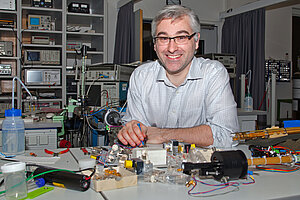Electron paramagnetic resonance (EPR) spectroscopy is a method to study molecules with unpaired electrons. Many of nature’s most complex catalysis (e.g. photosynthesis, molecular hydrogen formation, nitrogen fixation, etc.) involve unpaired electrons along the catalytic cycle. Typical EPR studies on frozen solution samples only provide information on the magnitude of the magnetic interaction. Instead, by studying these enzymes in single crystals the magnetic properties can be directly related to the crystal structure. However, volumes of the crystals used for x-ray diffraction are too small to provide adequate signal for EPR spectroscopy research.
Researchers from the Max Planck Institute for Chemical Energy Conversion <link>EPR Research Group and <link https: e3.physik.tu-dortmund.de cms de ag-suter index.html>Technische Universität Dortmund have developed a new microwave probe based on a helical geometry. By reducing the size of the EPR probe to only 0.4 mm by 1.2 mm, the microhelix increases the sensitivity on extremely volume limited samples, such as protein single-crystals, by a factor of 28. In order to demonstrate the usefulness of the microhelix, they teamed up with crystallography laboratories of Prof. Thomas Happe at Ruhr-Universität Bochum and Prof. Athina Zouni at Humboldt- Universität zu Berlin. With protein crystals of [FeFe]-hydrogenase from Clostridium pasteurianum (CpI) obtained from the Happe group, the full g-tensor of the active-site in the Hox stable intermediate was proposed from a crystal 0.3 mm by 0.1 mm by 0.1 mm.
"With this technical development we can, for the first time, study protein single-crystals of sizes typical for x-ray crystallography (less than 5 nl) using advanced EPR techniques,” study lead author Jason W. Sidabras explains. “These studies allow researchers to go beyond protein structure and obtain full orientation and magnitude information of magnetic properties at the active site of an enzyme. This information leads to a fundamental understanding of the catalytic mechanism of these enzymes.”
The development of the microhelix for EPR spectroscopy allows for a number of interesting experiments to be performed on protein single crystals. The information gather can also be used to benchmark quantum chemical calculations and further the development of biomimetics of nature’s most elusive chemistry.
The article, “Extending electron paramagnetic resonance to nanoliter volume protein single crystals using a self-resonant microhelix,” was published in Science Advances. DOI: <link https: doi.org sciadv.aay1394>10.1126/sciadv.aay1394
This work was funded by European Union Horizon 2020 Marie Skłodowska-Curie Fellowship (no. 745702; ACT-EPR, <link https: act-epr.org>
), the Max Planck Society, Sonderforschungsbereich Sfb1078 by Humboldt Universität zu Berlin, Project A5, Cluster of Excellence-2033 RESOLV #390677874 (Deutsche Forschungsgemeinschaft, DFG), DFG Research Training Group GRK 2341 Microbial Substrate Conversion (MiCon), and Volkswagen Stiftung (Design of [FeS] cluster containing Metallo-DNAzymes [Az 93412]).
Scientific Contacts:
Jason W. Sidabras - <link>jason.sidabras@cec.mpg.de
Edward Reijerse - <link>edward.reijerse@cec.mpg.de

